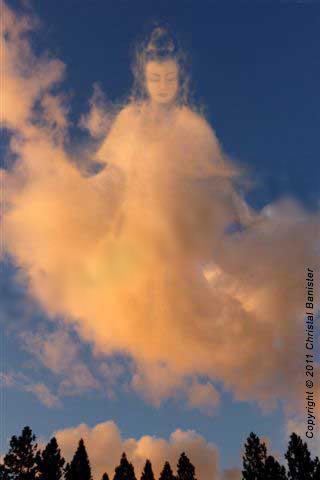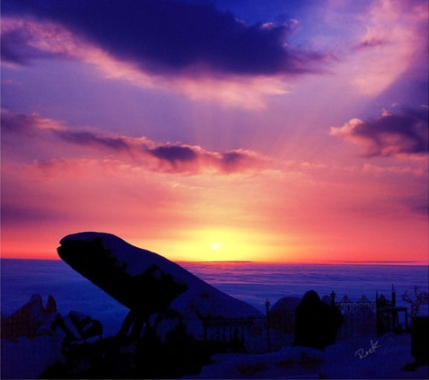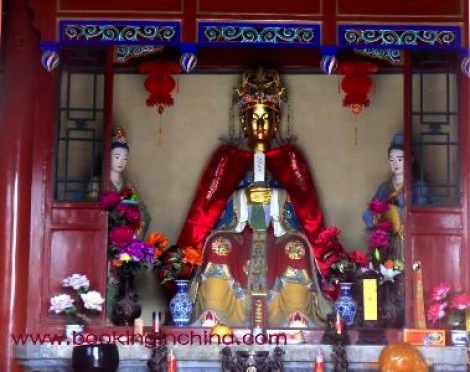
“Autumn Harvest” by Kandra Orr
“Chup’s themes are the harvest, reason, weather and providence. Her symbols are acorns, oak, rainwater and fire. As a Native American Goddess of food, Chup is the founder of our feast today, the Miwok Acorn Feast.* She oversees nature’s energies, specifically those of wind, rain and fire, and teaches people to use a combination of reason and their emotions to solve difficult problems.
This is an event of the Miwok people, who gather today as they have for thousands of years to celebrate the harvest through ritual and feasting. Acorns get made into breads and soups, having been a regional staple for early peoples.
Therefore, I advocate finding some creative uses for acorns, perhaps making them into runes or using them to mark the sacred circle in the east, west and south (the elemental regions that correspond to Chup).
To increase your reasoning skills, especially for a pressing situation, try this Chup spell: The next time it rains, gather the rainwater and warm it, gently blowing over the top of the pan three times and saying:
‘By Chup’s sensible winds, let this magic begin.
Within this water I bind keenness of mind.
By the fire actuate, all confusion abates.’
To this water add some spearmint leaves and a pinch of rosemary to augment conscious thought, then drink the tea to start the transformation process.”
(Patricia Telesco, “365 Goddess: a daily guide to the magic and inspiration of the goddess”.)
My goodness, this Goddess was difficult to find! I came across a Mayan moon Goddess called Ix-Chup and an Ainu moon/sun Goddess, Chup-Kamui, but no Chup. After searching through Miwok mythologies, stories and lists of their spirits (they seem to have had a very animistic world view), and even Miwok baby names, I came across a blog entry called “Just Call me Chup, the Chumash goddess of wind“. Yes! A clue! After Googling “Chumash goddess Chup”, I came across this paper on escholarship.org entitled, “The Integration of Myth and Ritual in South-Central California: The “Northern Complex” by Travis Hudson and Thomas Blackburn. After searching the PDF file I downloaded, I came across this piece of information:

“Gaia” by Susan Seddon Boulet
“Tsúqqit [Earth Goddess and creator of the human race with the help of Her five divine borthers], as mother of mankind and provider of knowledge, seems equivalent in some ways to earth; this suggests a secondary (or even primary?) Sky Father-Earth Mother theme with parallels elsewhere in southern California. The apparent Chumash equivalent is Chup, described as a provider of food and an important female supernatural being. It is interesting that Chup was frequently associated with the deer in Chumash ritual practices; for example, an ‘antap costumed as a deer opened the Earth ceremony, and deer-tibia whistles were used by the ‘antap during the ritual. The ‘antap were also said to have played these whistles at ‘Iwihinmu, where the appearance of deer apparently had ritual significance. The Chumash, like the Kitanemuk, also believed Sun and Earth were in balance with one another; this recalls the Kitanemuk belief that Sun and Tsúqqit were opponents in the celestial peon game…” (p. 237).
In her book, Goddess in a Box, Nancy Blair writes: “It’s nearly impossible to name only one attribute of this many-named Spirit Mother of the California Chumash people. She is the guardian of family and nation, intelligence, creativity and weather – the basic elements of life. She is the One in All, as so many female deities are. Her ritual name is Hütash. In many Native American languages, there are dozens if not hundreds of words to describe the natural World. One name doesn’t fit all contexts” (p. 43).

Earth Mother/Sky Father
Hope B. Werness writes: “Hutash (Chup or Shup in secular contexts). The Chumash and other California natives worshipped the earth as Hutash, a feminine being, source of all sustenance. Highly sacred, Hutash possessed will, reason, emotions and power. Her three aspects were wind, rain and fire – white, blue or black and red respectivley, depicted in the rainbow, a sign of plenty and good luck. Hutash was depicted as a large encompassing disk or circle in Luiseno and Diegueno sand paintings and in Chumash rock paintings. The Chumash believed the earth and heavens were equal and complementary forces, mirroring one another” (p. 139).

“Sadness of Gaia” by Josephine Wall
“In the Chumash story ‘The Rainbow Bridge,’ the Earth Goddess Hutash created the first people on Santa Cruz Island from seeds She gathered from a magic plant. One day Hutash’s husband, the Sky Snake (the Milky Way), gave the people the gift of fire. This gift warmed them and was used to cook food, which helped the people to grow strong and thrive. Soon the island became overcrowded. Hutash decided that some of the people would have to move to the mainland, and that’s how the Chumash came to populate the coastal mainland and what are now known as the Channel Islands.” [1]

“Earth Goddess” by Robert Florczak
* Please note: It was pointed out to me by a person of Miwok descent that Chup is indeed a Chumash Goddess derivative of a Mayan Goddess. There is no indication of a Goddess linked by that name to the Miwok and furthermore that there are no legends on such a Goddess. It is apparent that Patricia Telesco cross miss identified nations with the Acorn Festival and the Chumash – totally different peoples and different histories. My only thought on this is that as with many of her posts, Telesco meant to compare and illustrate the common essences of the two different cultures.
Sources:
Blair, Nancy. Goddess in a Box, “Chup“.
Hudson, Travis & Thomas Blackburn. Escholarship.org, “The Integration of Myth and Ritual in South-Central California: The ‘Northern Complex’“.
Native-languages.org, “Kitanemuk Legends“.
Weareca.org, “The Chumash Creation Story“.
Suggested Links:
Bsahighadventure.org, “The Chumash Creation Myth“.
Ortiz, Beverly. Encyclopedia of Religion and Nature, “Miwok People” (p. 1094 – 1096).
Heizer, Robert & William C. Sturtevant. Handbook of North American Indians, Volume 8: California, “Kitanemuk“, (p. 567 – 568).
Leeming, David Adams. Creation Myths of the World: An Encyclopedia, Volume 1, “Miwok“.
Rain.org, “The Rainbow Bridge, a Chumash Legend“.
Suntree, Susan. Sacred Sites: The Secret History of Southern California.
Wikipedia, “Miwok Mythology“.








































